Ask Ethan: How Much Of The Observable Universe Are We Failing To See?

There’s so much that we’ve discovered, looking as deeply as possible into the void. But what are we missing?
Start with the laws of physics, a Universe full of a specific amount matter and radiation, and a hot, dense, expanding, and mostly uniform state, and wait. 13.8 billion years later, you’ll have a Universe that looks an awful lot like our own. It’s full of stars, galaxies, clusters, filaments, and trillions upon trillions of chances for rocky planets, liquid water, and life. But how far does the accessible Universe go on for, and how much of it has yet to be revealed? That’s what our Patreon supporterFrederick Martello wants to know:
The Hubble Deep Field saw approx. 13+ Billion Light Years in one direction, so can we can assume we would see 13+ Billion in all directions? The deep field picture showed infant galaxies that are misshapen and just short of the first stars. The big bang itself lies just beyond. Does this imply that the entire universe is roughly 26+ Billion Light Years across? How is it that I have seen estimates showing we only see a small percentage of all the structure that is out there in our universe?
Let’s start with a look at the deepest view of the Universe humanity has ever taken, and go even deeper from there.
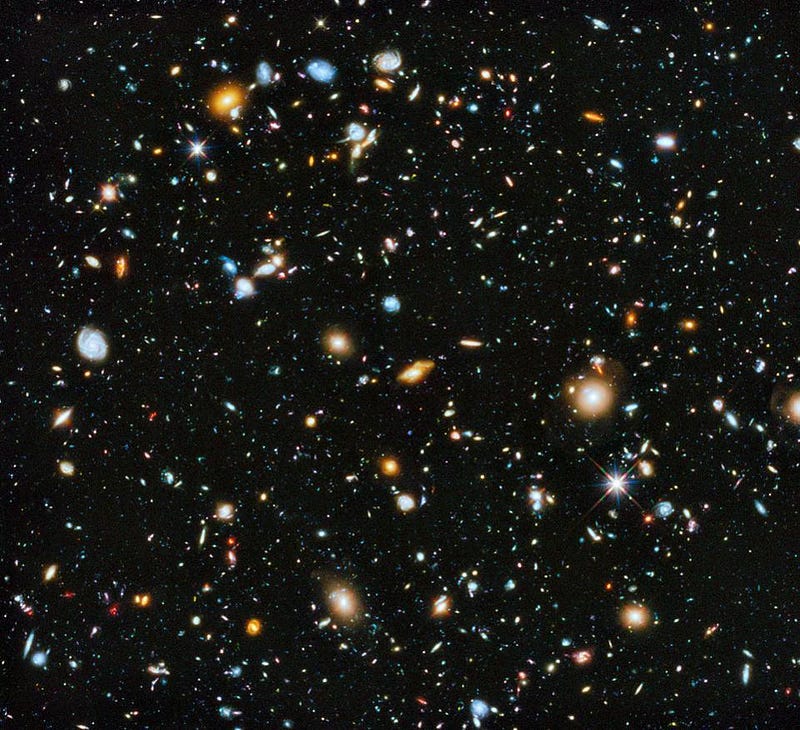
The Hubble eXtreme Deep Field is a view of a very tiny patch of sky — 1/32,000,000th of all that’s visible — viewed for a total of 23 days across the ultraviolet, visible, and near-infrared portions of the light spectrum. It found a total of 5,500 galaxies, some from relatively nearby and some from when the Universe was just 4% of its current age. If you were to do the math, and extrapolate 5,500 galaxies in this small region to the entire sky, you’d wind up with around 180 billion galaxies in the visible Universe. But that number is far too small, and accounts for only approximately 10% of the galaxies that are actually present.
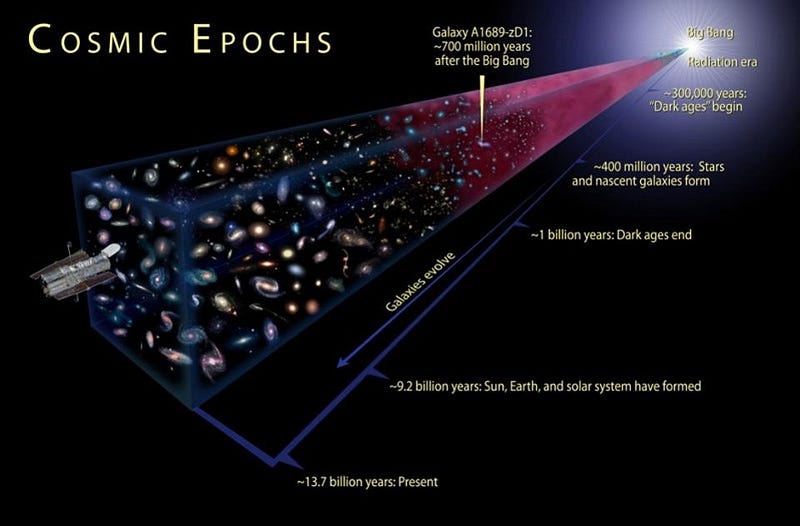
When we look back to extremely large distances, we’re also looking back in time. Light from distant galaxies can only travel at the speed of light, and the Universe today is precisely 13.8 billion years old. When you see light that took 100 million years to reach us, you’re seeing light from 100 million years back in time. With its greatest observations, Hubble can see galaxies from when the Universe was under 1 billion years old. As we look farther and farther back, we find that galaxies are, on average:
- smaller,
- lower in mass,
- intrinsically bluer in color (due to greater proportions of younger stars),
- and less intrinsically luminous, or fainter, due to the smaller number of stars inside.
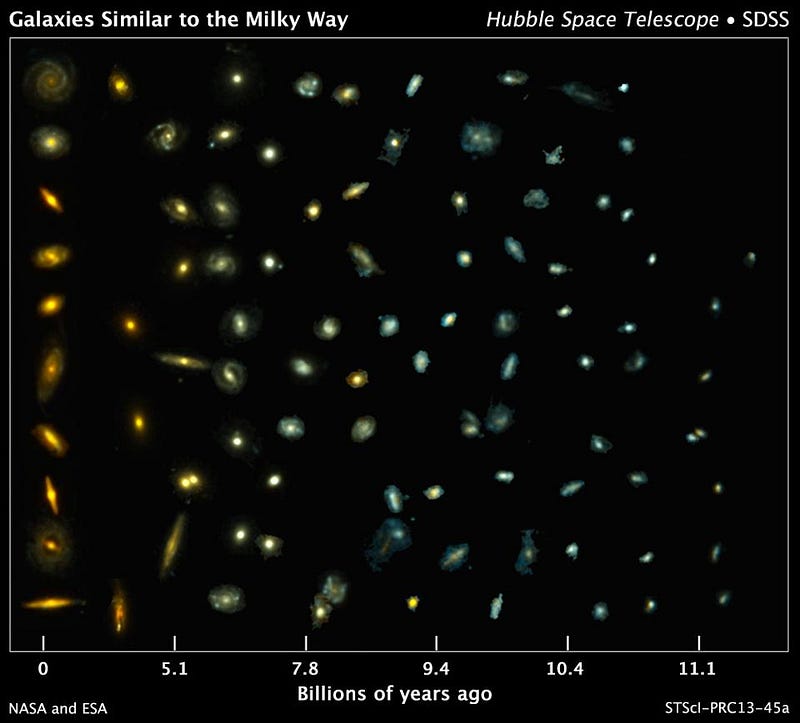
Much of this makes sense: it takes time for gravitation to pull these small, early proto-galaxies into large, massive, Milky Way-sized ones. It takes billions of years for large clusters of galaxies to form, giving rise to the most massive elliptical galaxies we know of. And yet, during those early days, these “seed” galaxies must have existed in great numbers.
If we want to understand how many there are, we have to combined the best of both worlds: the theoretical one, where we simulate the Universe based on the physics of all that we know, and the observational world, where we see everything accessible to our instruments and measurements.
When we combine both of these together, as a 2016 study showed, we learn that there are approximately two trillion galaxies in the full, observable Universe. They should be approximately uniform in all directions, with larger numbers of low-mass galaxies at great distances, and smaller numbers of galaxies weighted towards higher masses nearby. Yes, there will be clumps and clusters and filaments connecting them, along with great cosmic voids between them, but that’s due to the effect of gravitational attraction. On average, the Universe is the same everywhere.
So why is it, then, when we look out at the distant Universe, we’re only seeing approximately 9% of the galaxies that are out there? And in particular, why are we missing so many of the most distant galaxies?
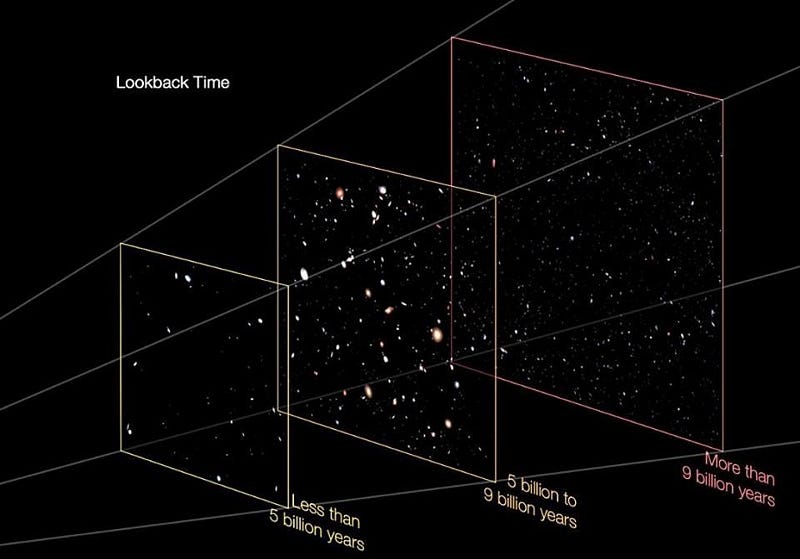
There are a few reasons at play, some of which are obvious and some of which aren’t. The most obvious one is that these galaxies are farther away, meaning that they’re harder to see. A galaxy that’s barely visible at a distance of 5 billion light years will be only a quarter as bright at 10 billion light years, meaning you’d have to observe it for four times as long to see it.
The second obvious reason is that these galaxies are intrinsically fainter, being smaller and full of fewer stars. A galaxy with 100 million stars might be only 0.1% as bright as a galaxy with 400 billion stars like the Milky Way, even when you factor in the notion that the younger galaxy has a higher proportion of brighter stars.
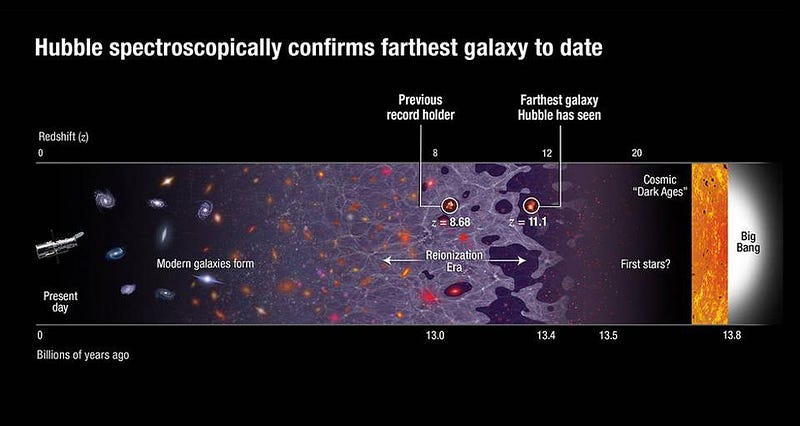
But then there are less obvious things at play. In the ultra-distant Universe, beyond a redshift of about 6, you have to begin contending with neutral gas, which blocks part of your starlight. It’s only where you have pockets of the Universe where there’s very little neutral gas left in a particular direction that the galaxies are visible. When this neutral gas is there, the light from the ultra-distant, ultra-faint galaxies gets washed out.
There’s also the effect of cosmic redshift. The fabric of the Universe itself is expanding, which is one of the most important parts of the Big Bang framework describing our Universe. This causes emitted light to have its wavelength stretched along with the expansion of space, making the more distant galaxies appear redder. The most distant galaxies will even have their ultraviolet light shifted all the way through the visible light spectrum and far into the infrared.

With the capability to detect a maximum wavelength of 1.6 microns, the Hubble eXtreme Deep Field reveals an incredible number of distant galaxies, but it leaves the most distant ones as undetectable, even in principle. This is why the James Webb Space Telescope will be so important, as it will be able to go to ultra-long infrared wavelengths all the way out to 30 microns: nearly 20 times the “stretch factor” of what Hubble is sensitive to.
Since neutral gas is less good at blocking infrared light, as you can see by looking at the gas-filled plane of our own galaxy, this means that beginning in 2019, we’re going to be poised to start observing these ultra-faint, ultra-distant galaxies at long last.
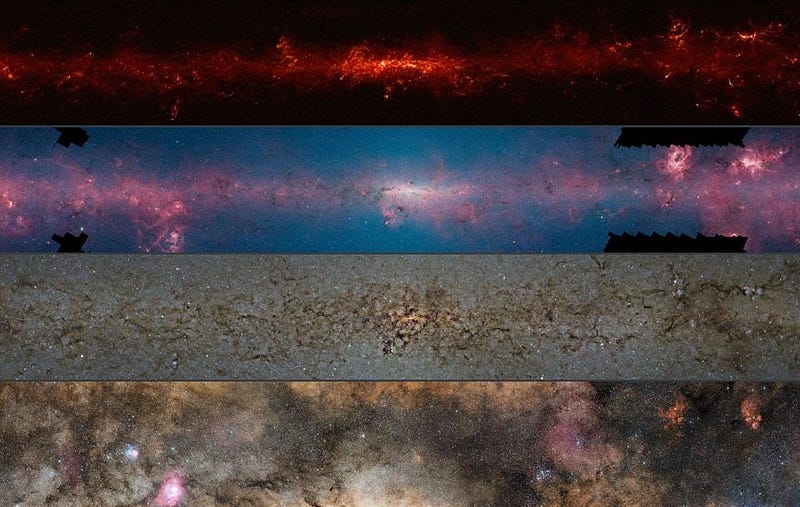
The last part of this — about the stretching of space — is also the last part of what makes observing these ultra-young galaxies so difficult. If the Universe weren’t expanding, a galaxy whose light traveled for 10 billion years to reach us would be at a distance of 10 billion light years. But in an expanding Universe, it’s farther away today, owing to the stretching of space. In fact, as we look out to various redshifts and speculate where we will (and won’t) find galaxies, we can calculate just how far away and how old the Universe was when that light arrives. Here’s what we find:
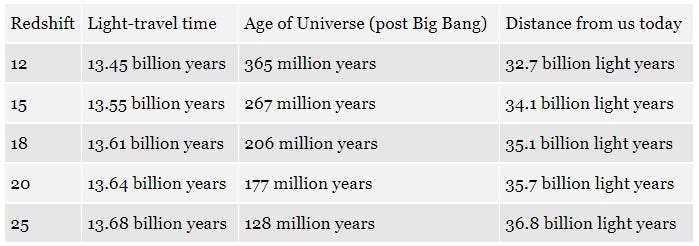
And even at that, the ones we’re able to detect, as small and faint as they are, are also the biggest and brightest of what the Universe has to offer at that time. To go all the way back to the moment of the Big Bang, 13.8 billion years ago, corresponds to a whopping distance of 46 billion light years. When the James Webb Space Telescope comes online, it should reveal the Universe as we’ve never seen it before.
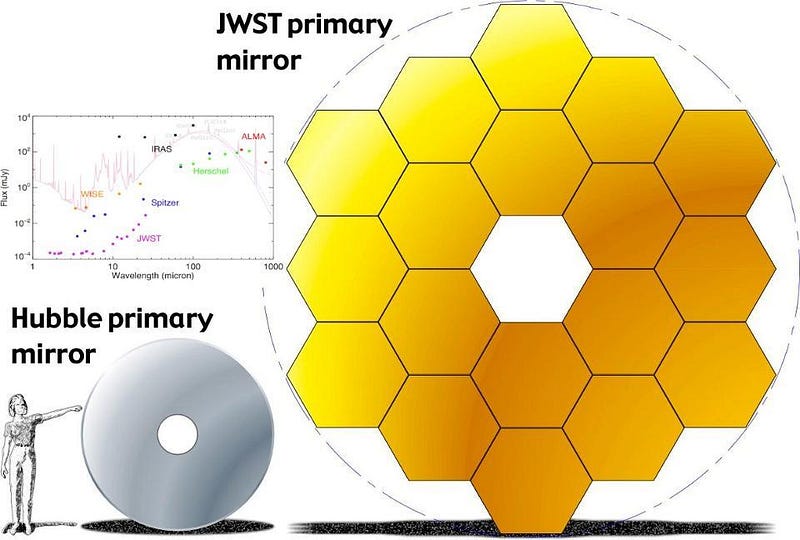
The Hubble Space Telescope taught us what the Universe looked like. In under two years, James Webb will take us to the next great leap forward, and teach us how the Universe grew up. It’s an incredible time to be alive. For anyone that’s curious what the first galaxies in the Universe looked like, how they formed, how young the Universe was when they first appeared, how distant they actually are, and how bright and massive these cosmic candles truly are, we’re on the cusp of having those questions answered. For generations, humanity had no idea where the stars and galaxies in the Universe came from. Before the decade is out, we’ll know those answers in details that would have been unimaginable even to Einstein.
Ethan Siegel is the author of Beyond the Galaxy and Treknology. You can pre-order his third book, currently in development: the Encyclopaedia Cosmologica.





